Have you heard about ChatGPT vs. Bard vs. Bing? These are three of the most advanced AI chatbots that can answer your questions, generate content, and even create images. But do you know how they are different?
This blog post will compare and contrast these large language models (LLMs) – ChatGPT Vs. Bard Vs. Bing based on their pricing, API, developer, technology, information access, best for, strengths, and weaknesses. We will also show you examples of how they respond to the same query and give you some tips on using them effectively.
Let’s get started!
ChatGPT Vs. Bard Vs. Bing: AI Comparison
| ChatGPT | Bard | Bing | |
| Pricing | Free (limited features), Paid tiers with increased features and access | Free (limited features, Beta), Future paid tiers planned | Free (limited features), Paid tiers with increased features and access |
| API | Yes, open-source and commercial options are available | Yes, currently in beta | Yes, open-source and commercial options are available |
| Developer | OpenAI | Google AI | Microsoft |
| Technology | GPT-3, GPT-3.5 (free version), and GPT-4 (paid version) | LaMDA | GPT-4 |
| Information Access | Up to September 2021 (free version), Real-time (paid version) | Real-time | Real-time |
| Best For | Creative writing, code generation, translation, and education | Information retrieval, summarization, research, and factual accuracy | Conversational interaction, detailed responses, and diverse styles |
| Strengths | Versatility, large community, creative output | Factual accuracy, speed, and research capabilities | User-friendly interface, diverse conversation styles, and integration with Microsoft products |
| Weaknesses | Limited information access (free version), potential for bias and factual errors | Less creative output compared to ChatGPT, still in Beta | Can be verbose, slower response times than Bard |
What Is GPT? What Is LaMDA?
ChatGPT Vs. Bard Vs. Bing uses different technologies for their platforms. So what are GPT and LaMDA?
What Is GPT?
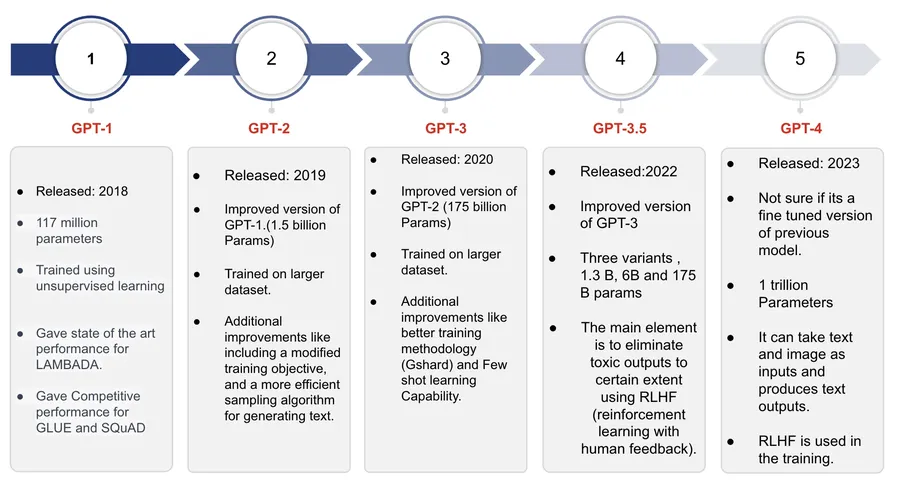
GPT-4: Both ChatGPT and Bing Chat are powered by OpenAI’s GPT-4, a massively complex neural network trained on a colossal dataset of text and code.
Its strengths lie in:
- Versatility: GPT-4 excels at producing realistic text across various formats, including creative writing, translation, and code generation.
- Community and Resources: OpenAI has released a public API for GPT-4, fostering a large and active developer community and leading to numerous research projects and applications.
- Creative Output: GPT-4 can produce highly engaging and imaginative text, making it popular for creative writing and storytelling.
However, limitations also exist:
- Accuracy: The massive dataset used for training can introduce biases and factual errors into GPT-4’s outputs.
- Limited Reasoning: While GPT-4 can generate text that appears logical, it may not always have a deep understanding of the content or reasoning behind it.
- Black Box Effect: Due to its complex structure, GPT-4’s decision-making process can be opaque, making it difficult to understand how it arrives at its outputs.
What Is LaMDA?
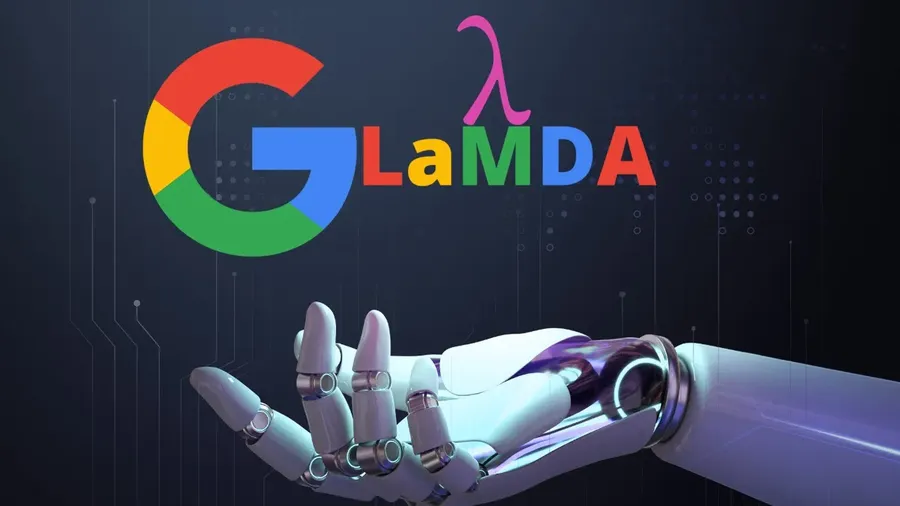
LaMDA: Bard is powered by Google’s LaMDA, a factual language model focused on understanding and responding to complex queries.
Its key strengths include:
- Accuracy: LaMDA prioritizes factual correctness and is trained on a dataset heavily curated for factual accuracy, minimizing bias and errors in its outputs.
- Reasoning: LaMDA can employ reasoning techniques to understand the context and implications of queries, leading to more informed and relevant responses.
- Research Capabilities: LaMDA has been a cornerstone in various research projects exploring aspects of factual language understanding and information retrieval.
However, limitations are also present:
- Creativity: While LaMDA can be creative in its factual responses, it may not excel at generating imaginative or non-factual content like GPT-4.
- Access: Currently, Bard is still in Beta and access is limited. This restricts its potential impact and hinders comparisons with publicly available models like GPT-4.
- Speed: LaMDA’s focus on factual accuracy can sometimes lead to slower response times compared to the faster, albeit less accurate, generation of GPT-4.
Examples of How ChatGPT Vs. Bard Vs. Bing Responds to The Same Query
Let’s see how ChatGPT vs. Bard vs. Bing answers the same question: “What Are The 3 Best Technical SEO Factors To Optimize My Site?”
ChatGPT: Smooth and Structured, But Needs Precision
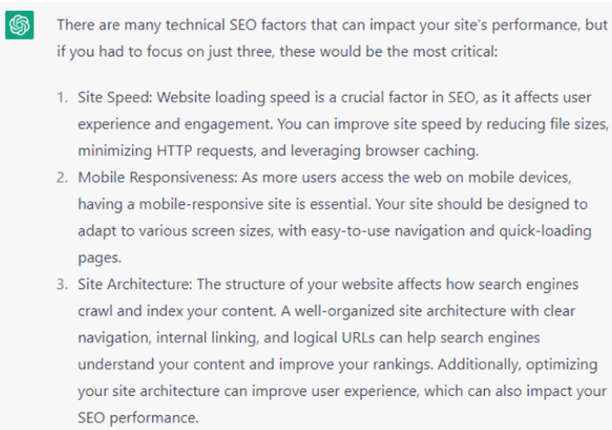
- Strengths: Coherent structure touches on important areas like site speed, mobile responsiveness, and site architecture.
- Weaknesses: Lacks some details on server-side caching and misinforms about caching plugins storing files on the user’s computer.
Bard: Fast and Formatted, with a Focus on Structured Data
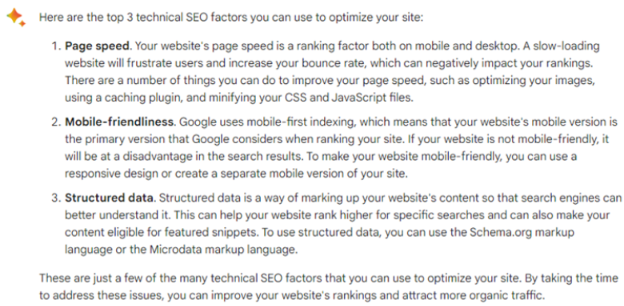
- Strengths: Faster response time, informative details, structured data, and Schema.org.
- Weaknesses: Similar inaccuracy about caching plugins as ChatGPT misses mentioning WebP image format.
Bing: Surprisingly Strong with Sources and Technical Accuracy
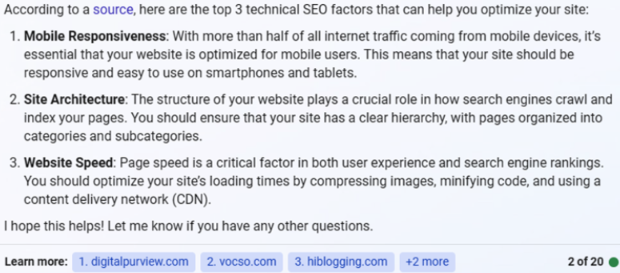
- Strengths: Provides sources for information and explains technical details like TTFB for caching.
- Weaknesses: Less elaborate responses compared to ChatGPT and Bard; don’t mention WebP format.
The Verdict:
ChatGPT’s comprehensive guidance and Bard’s focus on structured data are commendable. But in this technical SEO battle, Bing’s emphasis on source credibility, deeper caching explanation, and surprisingly high technical accuracy earned it the crown.
Tips for Using ChatGPT Vs. Bard Vs. Bing
Each AI language model, ChatGPT Vs. Bard Vs. Bing, has its strengths and weaknesses, making them suited for different situations. Here are some tips to help you get the most out of each one:
Before you use ChatGPT Vs. Bard Vs. Bing:
- Know your purpose: What do you want to achieve using the language model? This will help you choose the right tool for the job.
- Start with simple prompts: Don’t overwhelm the model with complex or ambiguous queries. Be clear and concise in your instructions.
- Provide context: The more context you give, the better the model can understand your request and generate a relevant response.
- Be aware of limitations: These models are still under development and can make mistakes. Be critical of the information they provide and double-check the facts.
- Experiment: Try all three models to see which works best for you.
- Give feedback: Let the developers know your experience using the models so they can improve them.
- Be responsible: Use these models ethically and avoid spreading misinformation.
Specific Tips for Each Model – ChatGPT Vs. Bard Vs. Bing:
- ChatGPT: Use it for brainstorming ideas, writing fiction, or translating short texts. Be cautious about factual accuracy, and avoid sensitive topics.
- Bard: Use it for research, fact-checking, summarizing information, or generating different creative text formats based on factual information.
- Bing: Use it for casual conversations, brainstorming ideas, or generating simple creative text formats. Explore the different conversation styles and image generation features.
Which Chatbot Is Better: ChatGPT Vs. Bard Vs. Bing?
The best choice of ChatGPT Vs. Bard Vs. Bing for you depends on your specific needs and preferences. If you need a versatile model for creative tasks, ChatGPT might be a good option. If you prioritize factual accuracy and research capabilities, Bard might be a better choice. And if you want a user-friendly model that integrates well with Microsoft products, Bing might be the best option.
Read More: 5 Best Ways to Use Google Bard to Write Emails
Contact US | ThimPress:
Website: https://thimpress.com/
Fanpage: https://www.facebook.com/ThimPress
YouTube: https://www.youtube.com/c/ThimPressDesign
Twitter (X): https://twitter.com/thimpress